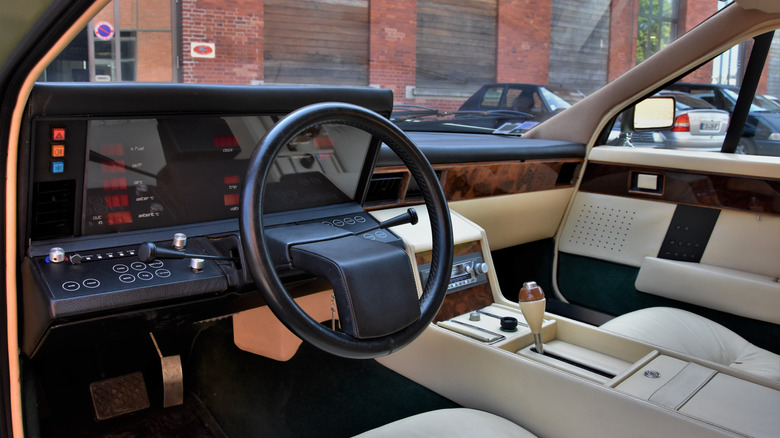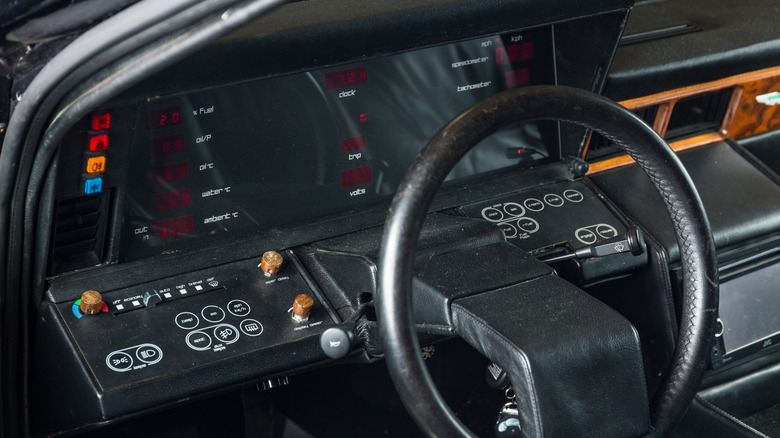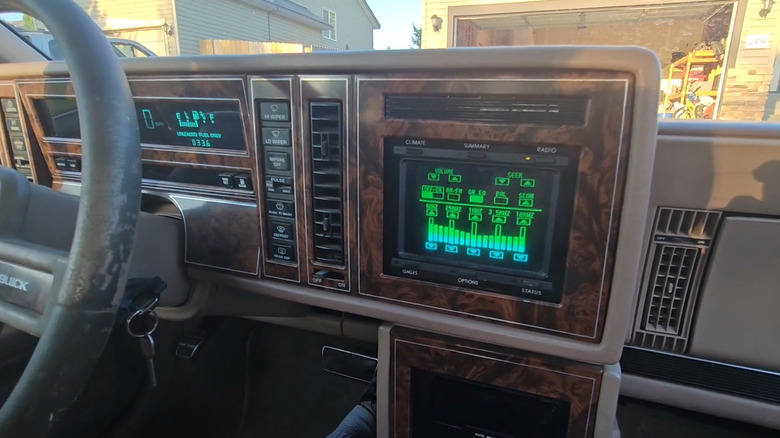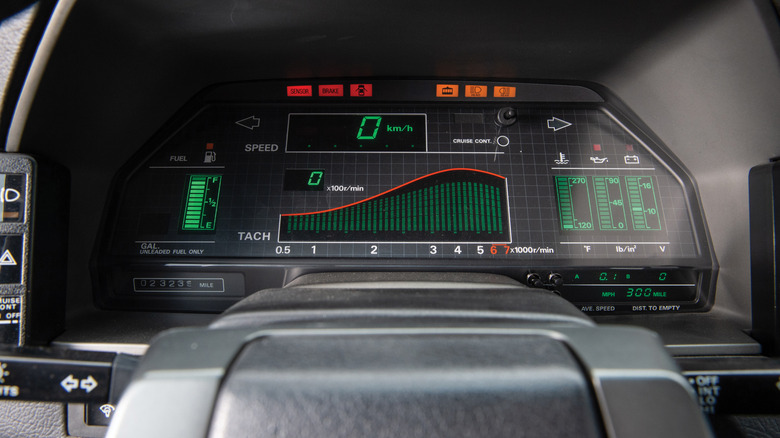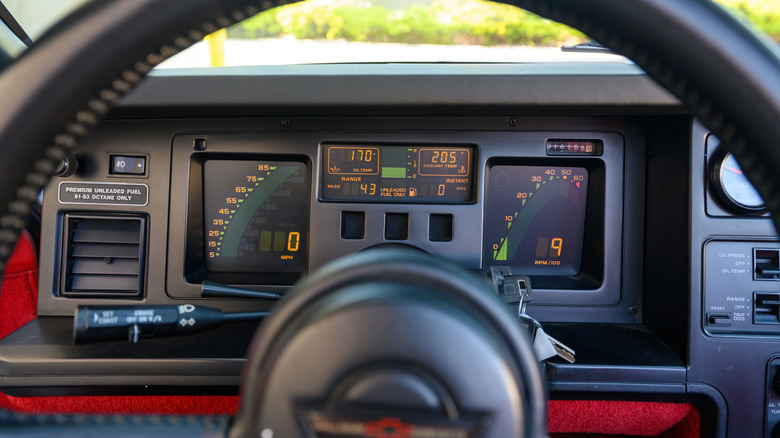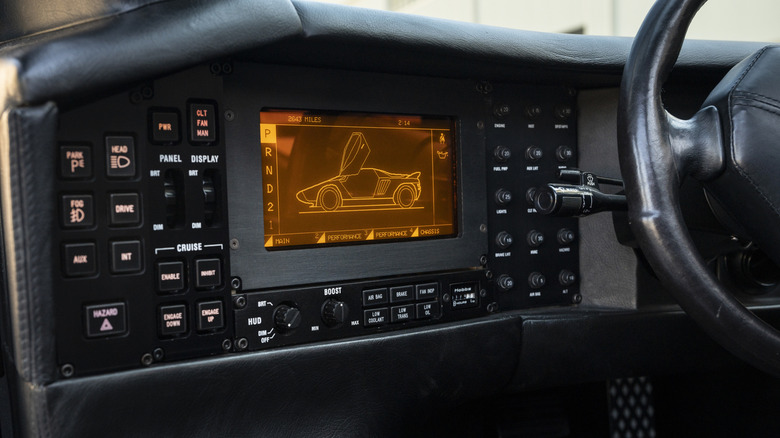5 Classic Cars That Had Digital Dashboards Way Before They Hit Mainstream
Digital dashboards are now the norm, with many cars featuring 14-inch or larger screens, or even multiple infotainment screens alongside digital instrument clusters that have replaced the analog gauges of old. But while this digital- and screen-overload is almost unavoidable now, most of you will likely remember a time when this wasn't the case, and analog dials and physical knobs were the only way to go.
While BMW's much-maligned iDrive touchscreen from 2002 and the arguably market-redefining 17-inch unit in the 2013 Tesla Model S are undoubted touchstones in the move from analog to digital, they weren't the first to do so. The earliest cars to go digital emerged decades before BMW's first iDrive-equipped model, with a selection of automakers in the late 1970s and 1980s deciding to replace outmoded dials and knobs with fancy all-digital interfaces. These made use of CRT displays, LEDs, and vacuum-fluorescent displays (VFDs) to offer buyers a new way to interface with their vehicles — aided, undoubtedly, by the brand-new and exciting world of microprocessors, which were coming into their own at the time.
Looking back, it's easy to feel like these cars were a bit too on the cutting edge. Unreliable electronics plagued some, while others would revert to analog dials when a successor emerged. Despite their fleeting and arguably dated nature, let's take a walk down memory lane and celebrate the pioneers of the digital car interiors that characterize our motoring lives today.
Aston Martin Lagonda
There's really no way of talking about early digital dashboards without mentioning the Series 2 Aston Martin Lagonda, sometimes considered the company's most expensive failure. First unveiled at the 1976 London Auto Show, the Lagonda was Aston Martin's attempt to revitalize itself after troubled times — and what a glorious, if flawed, attempt it was.
On the outside, the Lagonda was a wedge-like four-door with a gloriously long hood and angular, folded-paper design that sharpened to what is likely one of the thinnest front grilles the motoring world has ever seen. It wasn't a design that onlookers were likely to forget in the '70s and '80s, and it's still one that'll turn heads even now (even if, admittedly, not always for the right reasons). But, really, it's the Lagonda Series 2's digital dash that's the highlight of the show.
Reportedly the first-ever digital dashboard in a car, the Lagonda's futuristic digital interior did not have an easy birth. The first version by the U.K.'s Cranfield Institute was a complex mess, forcing Aston Martin to rope in Texas company Javalina Corporation to redo it. By the time Javalina was done, the Lagonda's price had nearly doubled, from £20,000 in 1976 to around £50,000 in 1979. What that money purchased, aside from the unmistakable styling and luxurious materials, was a futuristic LED dashboard, complete with soft-touch membrane buttons for user control. Unreliability and expense forced a switch to a three-CRT setup in 1984, before the Series 4 Lagonda adopted vacuum fluorescent gauges in 1987.
Buick Riviera
The Aston Martin Lagonda might have been the first-ever production car with a digital dash, but the honor of the first car with a touchscreen goes to a product from a much more quotidian brand: Buick. The seventh-generation Buick Riviera had a touchscreen that was genuinely ahead of its time, all thanks to fellow GM subsidiary Delco Systems, which had been developing a touch CRT for in-car use at around the same time that Buick's engineers were conceptualizing the Riviera.
And so, the seventh iteration of the Riviera nameplate — which had actually started life as a Cadillac — debuted for the 1986 model year with an interior that must have seemed downright mind-blowing at the time. While touchscreens may seem old hat now, it's worth remembering that the first touchscreen PCs, such as Hewlett-Packard's HP-150, had only debuted a few years earlier. The feature was thus likely totally alien to most, especially considering the HP-150 cost the equivalent of $9,000 in today's money.
The seventh-gen Riviera's central CRT touchscreen, which Buick called the Graphic Control Center (GCC), was quite modern in terms of what it could do, too. Like the in-car touchscreens of today, the Riviera's GCC allowed users to adjust climate control and the radio, but it could also be set to display a trip computer, fuel economy, and a rev counter. It could even show diagnostic information, giving owners a quick overview of the systems and highlighting any malfunctioning aspects — all delivered in that classic monochrome green glow of '80s CRTs. Buick paired this with a digital instrument cluster for a truly futuristic dashboard.
Nissan 300ZX
Nissan's Z cars had been around for about a decade and a half by the time the Z31 300ZX debuted in 1984. Arguably the first real revamp of the line, with the 240Z, 260Z, and 280Z all being nearly identical save for a gradual increase in engine displacement, the 300ZX ushered in a thoroughly mid-1980s design language — all clean, unobtrusive lines — and a 160-hp (200 hp in turbo form), 3.0-liter V6, the first V engine to power a Z car.
The visual makeover wasn't necessarily to everyone's taste, but the new mid-1980s Z car had it where it mattered. On the track, it was just as capable as its more feted older siblings in the right hands, and even road-going reviewers praised the new Z for its handling and driving dynamics. The unmistakable influence of the 1980s reared its head in more ways than just its exterior design language, though: Nissan also introduced a slice of the future into the passenger compartment with an optional Electronic Equipment Package. This package added, amongst others, an oh-so-1980s combination of digital gauges and woodgrain trim, alongside microcomputer-controlled automatic temperature control.
Nissan offered a thorough array of information via the Z31's digital instrument cluster, including: two tachometers (a pleasing graphic tach and a digital one); a digital speedometer; two trip odometers; and gauges for fuel, voltage, water temperature, and oil pressure. Barring the warning lights, which were in the standard red and orange, most of this information was presented via large green VFDs, in all their retro-cool glory.
Chevrolet C4 Corvette
The Chevrolet Corvette may not be a nameplate you'd associate with digital frippery, what with its unpretentious all-American muscle car heritage (at least, for most of its first few decades). However, Chevy's long-lived performance car got on the digital train relatively early compared to rivals.
The Chevrolet C4 debuted in 1984, trying to revive the nameplate after the C3 Corvette, sometimes considered the worst Corvette generation ever. It seemed to tick all the right boxes at launch, too, with Car and Driver calling it "a true-born, world-class sports car loaded with technical sophistication." High praise indeed, although the engine itself didn't seem all that big an improvement: the 5.7-liter V8 made 205 hp, only 15 or so horsepower more than the C3 'Vette did in its final years. Numbers climbed 230 hp in 1985, but it seemed that it was the C4 'Vette's technical improvements that gave it the edge.
Those improvements included its wind tunnel-guided design, which gave it a 0.34 drag coefficient — the lowest yet for a Corvette. But it was also a technological leap, bringing America's sports car into the digital age with dual computers, one of which was solely for monitoring, calculating, and displaying data to the driver via the C4's digital instrument cluster. This cluster had 14 readouts in nine sections, including eye-catching tachometer and speedometer bar graphs. While there don't seem to be many reports of the dash being particularly unreliable, GM switched back to analog dials for the 1997 C5 Corvette before finding a middle ground with a digital head-up display option in 1999.
Vector W8
Digital dashboards were quite exotic for a time, but few production cars of that era had digital interiors that were quite as out there as that of the Vector W8. And that's only fitting, really, seeing as how the W8 itself was probably one of the most attention-grabbing, left-of-center cars ever made, even by the standards of 1990s supercars.
The Vector W8 was the brainchild of one Jerry Wiegert, the culmination of nearly two decades' worth of concepts, development, and fundraising by the time W8s began to make their way to customers and journalists in the early 1990s. As you might expect for such a striking car, especially one with such a protracted gestation period, the W8 wasn't cheap, with a price tag reportedly close to $300,000 ($750,000 in 2025). What did buyers get for that eye-watering outlay, then? A turbocharged V8 that allegedly made 625 hp and took the car to 60 mph in 3.8 seconds in Car and Driver's hands, with a claimed top speed in excess of 200 mph.
As with other cars on this list, the W8 also caught the eye on the inside. It had a small CRT in the center console that displayed one of four screens, including one with the basics: speedometer, tachometer, and fuel gauge. Wiegert wanted the W8 to feel like a jet fighter inside, so he paired the screen with aerospace gear, including an Airpath compass and Hobbs time counter. Sadly, the Vector W8 was an expensive flop, and the company only sold 17 units.
